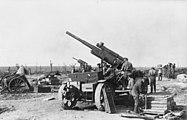8.8 cm Flak 16
| 8.8 cm Flak 16 | ||
|---|---|---|
Breech Horizontal sliding-block | | |
| Recoil | Hydro-pneumatic | |
| Carriage | Four-wheeled cruciform outriggers | |
| Elevation | -4° to +70° | |
| Traverse | 360°[1] | |
| Rate of fire | 10 rpm | |
| Muzzle velocity | 785 m/s (2,575 ft/s) | |
| Maximum firing range | Horizontal: 10.8 km (6.7 mi) Vertical: 6,850 m (22,470 ft)[1] | |
The 8.8 cm Flak 16 was a German 8.8 cm anti-aircraft gun from World War I, forerunner of the 8,8 cm
Development
Designs for dedicated anti-aircraft guns existed before World War I, but few were in service by the outbreak of war. Early anti-aircraft artillery guns used in World War I were primarily adaptations of existing medium-caliber weapons, mounted to enable fire at higher angles. By 1915, the German military command realized that these were useless for anything beyond deterrence, even against vulnerable balloons and slow-moving aircraft.[2] With the increase of aircraft performance, many armies developed dedicated AA guns with a high muzzle velocity – allowing the projectiles to reach greater altitudes. The first such German gun, the Flak 16, was introduced in 1917, using the 88 mm caliber, common in the Kaiserliche Marine.[2]
Design
The barrel for the 8.8 cm K.Zugflak L/45 was built from steel and was 45 calibers in length. The gun had a semi-automatic Krupp horizontal sliding-wedge breech to boost its rate of fire. There was a hydro-pneumatic recoil system located above and below the barrel, along with an equilibriator to balance the gun. The gun was capable of 360° of traverse and -4° to +70° of elevation.
See also
Photo Gallery
References
- ^ )
- ^ ISBN 9780700614202.



